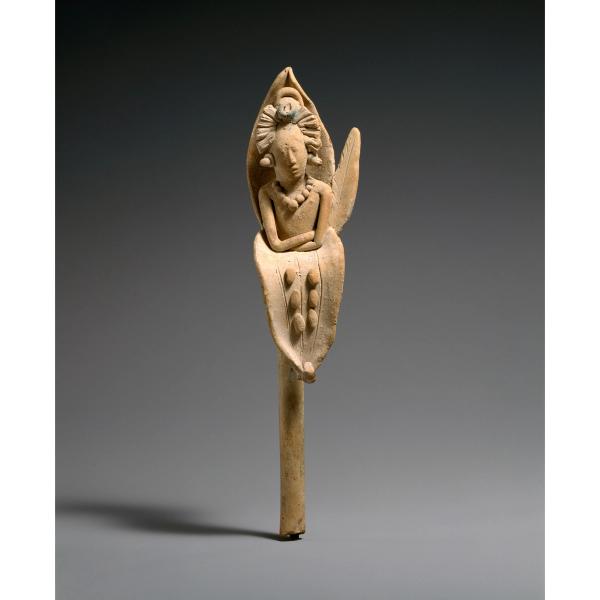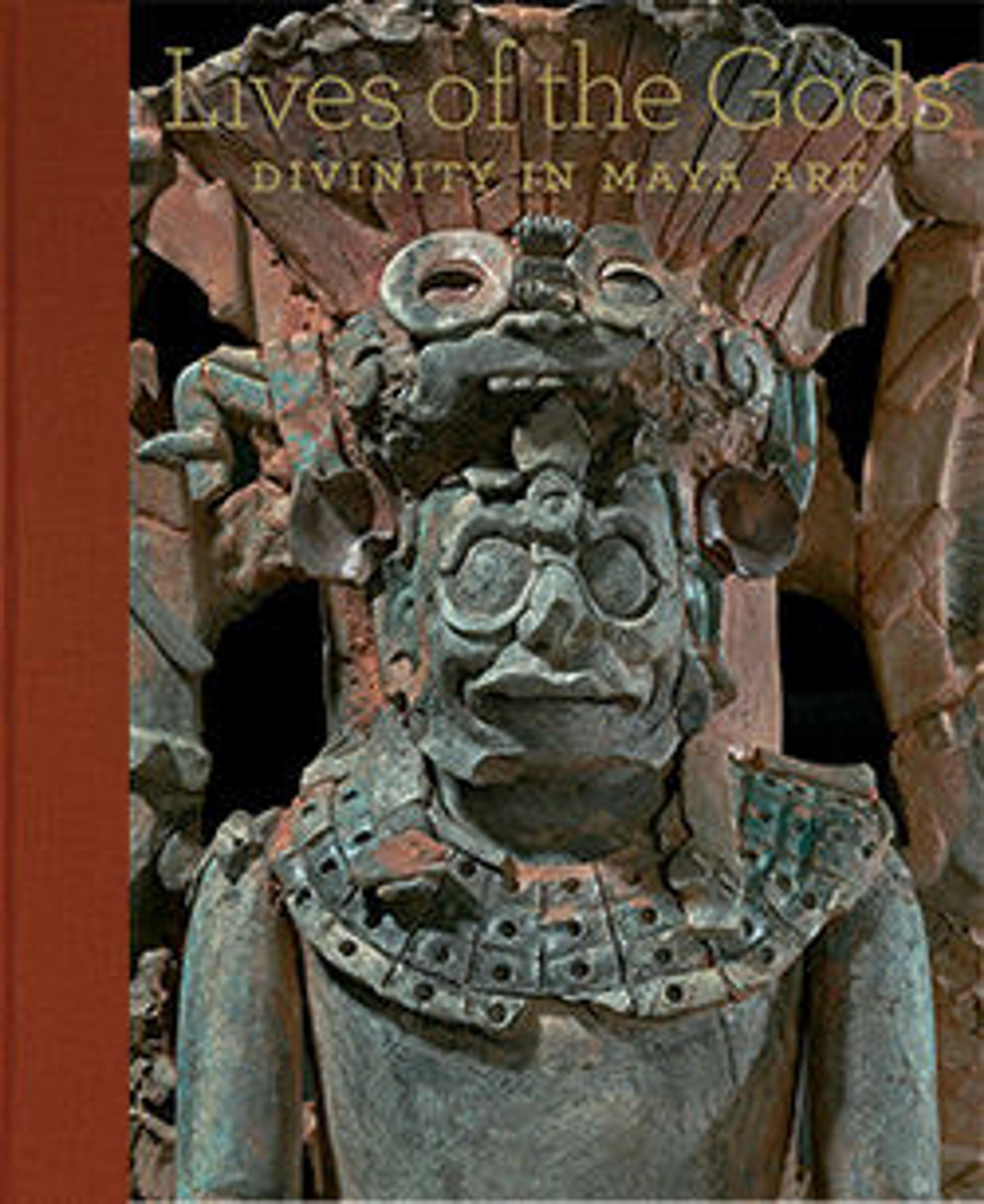Whistle with the Maize God emerging from a flower
The ear of corn sprouts from a long, narrow stem that is unadorned except for some minor areas of extant blue pigment. A tall, almond-shaped leaf stands upright behind the figure with three vertical lines gently incised on its outer surface (the back of the sculpture); another leaf of similar shape and size folds gently down in front to reveal six grains of corn arranged in two parallel vertical rows visually separated by three incised lines. A third blade-like leaf, shorter and narrower than the others, projects diagonally from the proper left side of the sculpture.
This object is probably from Jaina Island (present-day Campeche) in Mexico. It bears striking similarities to other hand-modeled Jaina figurines and effigies that depict deities emerging from flowers or other vegetation. While the depiction of identifiable deities is relatively uncommon in Jaina figurines, this sub-group of Jaina sculpture seems to portray gods exclusively.
References and Further Reading
Finamore, Daniel and Stephen D. Houston. 2010. Fiery Pool: The Maya and the Mythic Sea. Salem, MA: Peabody Essex Museum and New Haven: Yale University Press. Pl. 16, Pp. 58-61.
For comparanda and original definition of this subgroup of Jaina figurines, see:
Miller, Mary Ellen. 1975. Jaina Figurines: A Study of Maya Iconography. Princeton: Princeton University Art Museum. Figs. 22-24, p. 52.
O'Neil, Megan E. 2012. Jaina-style Figurines. In Ancient Maya Art at Dumbarton Oaks (edited by Joanne Pillsbury, Miriam Doutriaux, Reiko Ishihara-Brito, and Alexandre Tokovinine), 398-430. Washington, D.C.: Dumbarton Oaks Research Library and Collection.
For comparanda:
Finamore, Daniel and Stephen D. Houston. 2010. Fiery Pool: The Maya and the Mythic Sea. New Haven: Yale University Press and Salem: Peabody Essex Museum. [Pp. 60-61, Pls. 15, 16]
Schmidt, Peter, Mercedes de la Garza, and Enrique Nalda. 1998. Maya. Milan: Rizzoli/Bompiani. [p. 593, Pls. 299, 300]
Artwork Details
- Title:Whistle with the Maize God emerging from a flower
- Artist:Maya artist(s)
- Date:600–900 CE
- Geography:Mexico, Mesoamerica, Campeche, Jaina Island(?)
- Culture:Maya
- Medium:Ceramic, Maya blue and hematite pigments
- Dimensions:H. 8 1/8 x W. 2 x D. 1 1/2 in. (20.7 x 5.1 x 3.8 cm)
- Classification:Ceramics-Sculpture
- Credit Line:The Michael C. Rockefeller Memorial Collection, Bequest of Nelson A. Rockefeller, 1979
- Object Number:1979.206.728
- Curatorial Department: The Michael C. Rockefeller Wing
Audio

1632. Whistle with the Maize God emerging from a flower, Maya artist(s)
Laura Filloy Nadal
JOSÉ MARÍA YAZPIK (NARRATOR): These ceramic objects are decorated with a rare and innovative color. Look closely at the delicate figure emerging from an ear of corn; you can see remnants of a blue pigment on its headdress. Laura Filloy Nadal, Metropolitan Museum of Art.
LAURA FILLOY NADAL: Maya blue is a distinct and luxurious pigment created by the ancient Maya. The actual creation is quite a remarkable technological achievement. It is an artificial pigment made with the indigo plant dye commonly used today to dye denim and also a palygorskite clay. Palygorskite is a mineral clay, and the only known source in the Maya region is found in the Yucatan Peninsula.
With the use of heat, this porous clay chemically combines and melts with the blue dye, the pigment then becomes part of the clay, making the Maya blue one of the most durable pigments in Mesoamerica.
JOSÉ MARÍA YAZPIK: The Maya considered blue and green one color – called “yax” – which represented humidity, fertility, and luxury. The maize god is deeply connected to these concepts.
LAURA FILLOY NADAL: This delicate human figure is emerging as a corncob from a husk or a pistil from a flower. This version of the deity represents him in a still position with arms crossed. Here, the maize god stares at you. He’s depicted as a metaphor for a new growth and regeneration. Its body is painted in bright red pigment.
The head of this young deity conceals a whistle mechanism, and when the air is blown through the long, hollow stem, it produces a high pitch sound.
[WHISTLE SOUND]
JOSÉ MARÍA YAZPIK: In complex rituals, Maya worshipers used sounds to call out to divine entities, requesting supernatural interventions.
More Artwork
Research Resources
The Met provides unparalleled resources for research and welcomes an international community of students and scholars. The Met's Open Access API is where creators and researchers can connect to the The Met collection. Open Access data and public domain images are available for unrestricted commercial and noncommercial use without permission or fee.
To request images under copyright and other restrictions, please use this Image Request form.
Feedback
We continue to research and examine historical and cultural context for objects in The Met collection. If you have comments or questions about this object record, please contact us using the form below. The Museum looks forward to receiving your comments.
